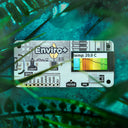Enviro for Raspberry Pi
by Pimoroni



Monitor your world with Enviro and Enviro + Air Quality for Raspberry Pi!
There's a whole bunch of fancy environmental sensors on these boards, and a gorgeous little full-colour LCD to display your data. They're the perfect way to get started with citizen science and environmental monitoring!
Monitor your world!
Enviro + Air Quality is designed for environmental monitoring, and lets you measure air quality (pollutant gases and particulates*), temperature, pressure, humidity, light, and noise level. When combined with a particulate matter sensor*, it's great for monitoring air quality just outside your house (more information below) and lets you contribute your data to citizen science efforts to monitor air quality via projects like Sensor Community.
Enviro is designed for indoor monitoring, letting you measure temperature, pressure, humidity, light, and noise level. It's great for keeping tabs on what's going on in rooms in your house, office, or elsewhere. Push the data to server and you can view the data remotely from anywhere.
Enviro + Air Quality features
- BME280 temperature, pressure, humidity sensor (datasheet)
- LTR-559 light and proximity sensor (datasheet)
- MICS6814 analog gas sensor (datasheet)
- ADS1015 analog to digital converter (ADC) (datasheet) *
- MEMS microphone (datasheet)
- 0.96" colour LCD (160x80)
- Connector for particulate matter (PM) sensor (available separately)
- Pimoroni breakout-compatible pin header
- pHAT-format board
- Fully-assembled
- Compatible with all 40-pin header Raspberry Pi models
- Pinout
- Python library
- Dimensions: 65x30x8.5mm
- Schematics - Enviro / Enviro + Air Quality
Enviro features
- BME280 temperature, pressure, humidity sensor (datasheet)
- LTR-559 light and proximity sensor (datasheet)
- MEMS microphone (datasheet)
- 0.96" colour LCD (160x80)
- Pimoroni breakout-compatible pin header
- pHAT-format board
- Fully-assembled
- Compatible with all 40-pin header Raspberry Pi models
- Python library
- Dimensions: 65x30x8.5mm
Citizen science with Enviro + Air Quality
We've developed Enviro + Air Quality in collaboration with the University of Sheffield, with the aim of letting you contribute real-time air quality data from your local area to open data projects like Sensor Community.
The alarming drop in our air quality is something that's really important to understand. Devices like Enviro + Air Quality allow fine-grained, detailed datasets that let us see shifts in air quality through time and across different areas of cities. The more devices that contribute data, the better quality the dataset becomes.
Particulate matter (PM) is made up of tiny particles that are a mix of sizes and types, like dust, pollen, mould spores, smoke particles, organic particles and metal ions, and more. Particulates are much of what we think of as air pollution. They can be measured, in size and quantity, by particulate matter sensors like the PMS5003 that you can connect to Enviro + Air Quality.
The analog gas sensor can be used to make qualitative measurements of changes in gas concentrations, so you can tell broadly if the three groups of gases are increasing or decreasing in abundance. Without laboratory conditions or calibration, you won't be able to say "the concentration of carbon monoxide is n parts per million", for example.
Temperature, air pressure and humidity can all affect particulate levels (and the gas sensor readings) too, so the BME280 sensor on Enviro + Air Quality is really important to understanding the other data that it outputs.
We've got a tutorial that shows you how to use Enviro + Air Quality and a few easily-available bits to build the board into a weather-proof housing that you can mount outside your house to monitor local air quality.
Indoor monitoring with Enviro
Enviro is designed especially for indoor monitoring. The temperature, humidity, light, and noise readings can be used to keep track of conditions in your home and, combined with the LCD to display the data and the proximity sensor for interaction, it makes an ideal headless monitoring device.
Why not combine it with some IoT smarts like an Alexa skill so that you can ask what the temperature or humidity is? Or you could set up a trigger action with IFTTT that turns your Philips Hue lights on when the light level drops below a certain level. There's loads of possibilities!
Software
We've put together a Python library to control all the parts of your Enviro and Enviro + Air Quality. There's a bunch of examples for each of the individual parts, all-in-one examples that shows you the data from the sensors in a visual way. There's also an example that shows you how to contribute data to Sensor Community (requires Enviro + Air Quality and particulate matter sensor).
Getting started
Have a read through our (exhaustive!) Getting Started with Enviro+ tutorial that walks you through how to install the software, how to run the code examples, and how to use the Python library.
Notes
-
Enviro + Air Quality
PIM458£45.00 -
Enviro
PIM486£25.00
Enviro + Air Quality extras
Get particular about particulates 🍃
-
PMS5003 Particulate Matter Sensor with Cable+ £20.75
Shop with confidence – we've been serving the hobbyist electronics, Maker, and retro gaming communities since 2012.
- Satisfaction or refund guarantee
- Worldwide shipping via mail or courier
- 57,000+ customer reviews
- Secure website and payments